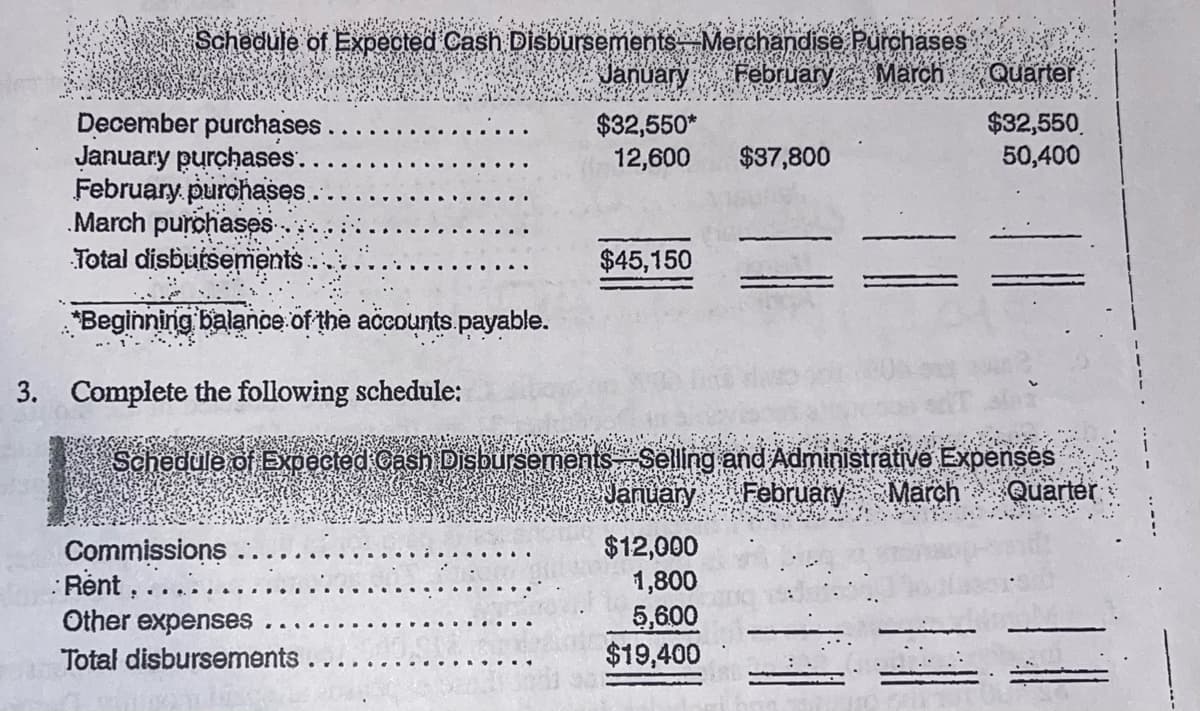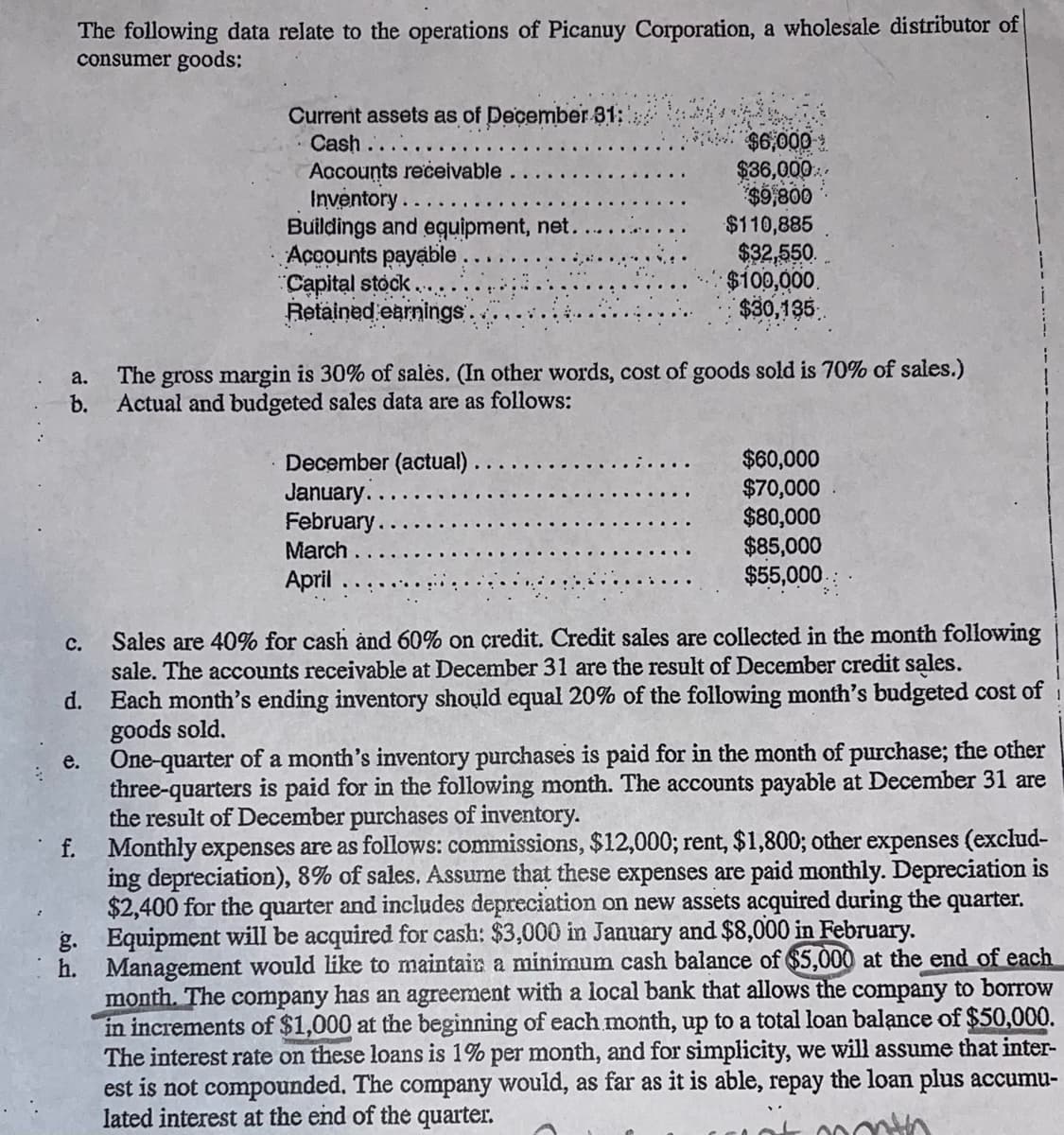The following data relate to the operations of Picanuy Corporation, a wholesale distributor of consumer goods: C. d. Current assets as of December 31: Cash Accounts receivable Inventory.. a. The gross margin is 30% of sales. (In other words, cost of goods sold is 70% of sales.) b. Actual and budgeted sales data are as follows: e. Buildings and equipment, net. Accounts payable Capital stock. Retained earnings. December (actual). January. February $6,000 $36,000 $9,800 $110,885 $32,550 $100,000. $30,135 March April $60,000 $70,000 $80,000 $85,000 $55,000 Sales are 40% for cash and 60% on credit. Credit sales are collected in the month following sale. The accounts receivable at December 31 are the result of December credit sales. Each month's ending inventory should equal 20% of the following month's budgeted cost of goods sold. One-quarter of a month's inventory purchases is paid for in the month of purchase; the other three-quarters is paid for in the following month. The accounts payable at December 31 are the result of December purchases of inventory. h. f. Monthly expenses are as follows: commissions, $12,000; rent, $1,800; other expenses (exclud- ing depreciation), 8% of sales. Assume that these expenses are paid monthly. Depreciation is $2,400 for the quarter and includes depreciation on new assets acquired during the quarter. g. Equipment will be acquired for cash: $3,000 in January and $8,000 in February. Management would like to maintain a minimum cash balance of $5,000 at the end of each month. The company has an agreement with a local bank that allows the company to borrow in increments of $1,000 at the beginning of each month, up to a total loan balance of $50,000. The interest rate on these loans is 1% per month, and for simplicity, we will assume that inter- est is not compounded. The company would, as far as it is able, repay the loan plus accumu- lated interest at the end of the quarter.
The following data relate to the operations of Picanuy Corporation, a wholesale distributor of consumer goods: C. d. Current assets as of December 31: Cash Accounts receivable Inventory.. a. The gross margin is 30% of sales. (In other words, cost of goods sold is 70% of sales.) b. Actual and budgeted sales data are as follows: e. Buildings and equipment, net. Accounts payable Capital stock. Retained earnings. December (actual). January. February $6,000 $36,000 $9,800 $110,885 $32,550 $100,000. $30,135 March April $60,000 $70,000 $80,000 $85,000 $55,000 Sales are 40% for cash and 60% on credit. Credit sales are collected in the month following sale. The accounts receivable at December 31 are the result of December credit sales. Each month's ending inventory should equal 20% of the following month's budgeted cost of goods sold. One-quarter of a month's inventory purchases is paid for in the month of purchase; the other three-quarters is paid for in the following month. The accounts payable at December 31 are the result of December purchases of inventory. h. f. Monthly expenses are as follows: commissions, $12,000; rent, $1,800; other expenses (exclud- ing depreciation), 8% of sales. Assume that these expenses are paid monthly. Depreciation is $2,400 for the quarter and includes depreciation on new assets acquired during the quarter. g. Equipment will be acquired for cash: $3,000 in January and $8,000 in February. Management would like to maintain a minimum cash balance of $5,000 at the end of each month. The company has an agreement with a local bank that allows the company to borrow in increments of $1,000 at the beginning of each month, up to a total loan balance of $50,000. The interest rate on these loans is 1% per month, and for simplicity, we will assume that inter- est is not compounded. The company would, as far as it is able, repay the loan plus accumu- lated interest at the end of the quarter.
Managerial Accounting
15th Edition
ISBN:9781337912020
Author:Carl Warren, Ph.d. Cma William B. Tayler
Publisher:Carl Warren, Ph.d. Cma William B. Tayler
Chapter8: Budgeting
Section: Chapter Questions
Problem 17E
Related questions
Question
100%
Solve these two problems with data given - please provide instructions on answers

Transcribed Image Text:Schedule of Expected Cash Disbursements Merchandise Purchases
January February March Quarter
December purchases..
January purchases.
February purchases.
March purchases.
Total disbursements.
*Beginning balance of the accounts.payable.
$32,550*
12,600 $37,800
Commissions
Rent.
Other expenses
Total disbursements
$45,150
3. Complete the following schedule:
Schedule of Expected Cash Disbursements Selling and Administrative Expenses
February March Quarter
January
$32,550
50,400
$12,000
1,800
5,600
$19,400

Transcribed Image Text:The following data relate to the operations of Picanuy Corporation, a wholesale distributor of
consumer goods:
a.
b.
C.
d.
e.
f.
g.
h.
Current assets as of December 31:
Cash.
Accounts receivable
Inventory..
Buildings and equipment, net.
Accounts payable
Capital stock..
Retained earnings.
$6,000
$36,000
$9,800
$110,885
$32,550.
$100,000.
$30,135
The gross margin is 30% of sales. (In other words, cost of goods sold is 70% of sales.)
Actual and budgeted sales data are as follows:
December (actual).
January.
February..
March..
April
$60,000
$70,000
$80,000
$85,000
$55,000.
Sales are 40% for cash and 60% on credit. Credit sales are collected in the month following
sale. The accounts receivable at December 31 are the result of December credit sales.
Each month's ending inventory should equal 20% of the following month's budgeted cost of
goods sold.
One-quarter of a month's inventory purchases is paid for in the month of purchase; the other
three-quarters is paid for in the following month. The accounts payable at December 31 are
the result of December purchases of inventory.
Monthly expenses are as follows: commissions, $12,000; rent, $1,800; other expenses (exclud-
ing depreciation), 8% of sales. Assume that these expenses are paid monthly. Depreciation is
$2,400 for the quarter and includes depreciation on new assets acquired during the quarter.
Equipment will be acquired for cash: $3,000 in January and $8,000 in February.
Management would like to maintain a minimum cash balance of $5,000 at the end of each
month. The company has an agreement with a local bank that allows the company to borrow
in increments of $1,000 at the beginning of each month, up to a total loan balance of $50,000.
The interest rate on these loans is 1% per month, and for simplicity, we will assume that inter-
est is not compounded. The company would, as far as it is able, repay the loan plus accumu-
lated interest at the end of the quarter.
moth
Expert Solution
This question has been solved!
Explore an expertly crafted, step-by-step solution for a thorough understanding of key concepts.
Step by step
Solved in 3 steps

Follow-up Questions
Read through expert solutions to related follow-up questions below.
Follow-up Question
why did you multiple required purchases by 1/4 & 3/4? I am confused on this as i dont see it in the instructions.
Solution
Knowledge Booster
Learn more about
Need a deep-dive on the concept behind this application? Look no further. Learn more about this topic, accounting and related others by exploring similar questions and additional content below.Recommended textbooks for you

Managerial Accounting
Accounting
ISBN:
9781337912020
Author:
Carl Warren, Ph.d. Cma William B. Tayler
Publisher:
South-Western College Pub

Financial And Managerial Accounting
Accounting
ISBN:
9781337902663
Author:
WARREN, Carl S.
Publisher:
Cengage Learning,

College Accounting, Chapters 1-27
Accounting
ISBN:
9781337794756
Author:
HEINTZ, James A.
Publisher:
Cengage Learning,

Managerial Accounting
Accounting
ISBN:
9781337912020
Author:
Carl Warren, Ph.d. Cma William B. Tayler
Publisher:
South-Western College Pub

Financial And Managerial Accounting
Accounting
ISBN:
9781337902663
Author:
WARREN, Carl S.
Publisher:
Cengage Learning,

College Accounting, Chapters 1-27
Accounting
ISBN:
9781337794756
Author:
HEINTZ, James A.
Publisher:
Cengage Learning,


Survey of Accounting (Accounting I)
Accounting
ISBN:
9781305961883
Author:
Carl Warren
Publisher:
Cengage Learning

Century 21 Accounting Multicolumn Journal
Accounting
ISBN:
9781337679503
Author:
Gilbertson
Publisher:
Cengage